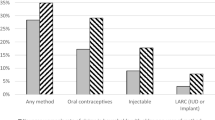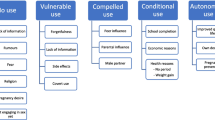ABSTRACT
Unintended pregnancy is a public health problem with societal consequences. The Contraceptive CHOICE Project (CHOICE) demonstrated a reduction in teen pregnancy and abortion by removing barriers to effective contraception. The purpose of the study was to describe the dissemination approach used to create awareness of and promote desire to adopt the CHOICE model among selected audiences. We used a 4-stage approach and detail the work completed in the first 2 stages. We describe stakeholder involvement in the first stage and the process of undertaking core strategies in the second stage. We examine insights gained throughout the process. Through our dissemination approach, we reached an estimated 300,000 targeted individuals, not including the population reached through media. We were contacted by 141 entities for technical assistance. The completion and reporting of dissemination processes is an important component of research. There is a need to fully document and disseminate strategies that can help facilitate practice change.
Similar content being viewed by others
References
Finer LB, Zolna MR. Unintended pregnancy in the United States: incidence and disparities, 2006. Contraception. 2011; 84(5): 478-485.
Finer LB, Henshaw SK. Disparities in rates of unintended pregnancy in the United States, 1994 and 2001. Perspect Sex Reprod Health. 2006; 38(2): 90-96.
Schwarz EB, Smith R, Steinauer J, Reeves MF, Caughey AB. Measuring the effects of unintended pregnancy on women’s quality of life. Contraception. 2008; 78(3): 204-210.
Hellerstedt WL, Pirie PL, Lando HA, et al. Differences in preconceptional and prenatal behaviors in women with intended and unintended pregnancies. Am J Public Health. 1998; 88(4): 663-666.
Sonfield A, Kost K. Public costs from unintended pregnancies and the role of public insurance programs in paying for pregnancy and infant care: estimates for 2008. New York: Guttmacher Institute; 2013.
Secura GM, Allsworth JE, Madden T, Mullersman JL, Peipert JF. The contraceptive CHOICE Project: reducing barriers to long-acting reversible contraception. Am J Obstet Gynecol. 2010; 203(2): 115 e111-117.
Peipert JF, Madden T, Allsworth JE, Secura GM. Preventing unintended pregnancies by providing no-cost contraception. Obstet Gynecol. 2012; 120(6): 1291-1297.
Secura GM, Madden T, McNicholas C, Mullersman J, Buckel CM, Zhao Q, Peipert JF. Provision of no-cost, long-acting contraception and teenage pregnancy. N Engl J Med. 2014; 371(14): 1316-1323.
Glasgow RE, Vinson C, Chambers D, Khoury MJ, Kaplan RM, Hunter C. National Institutes of Health approaches to dissemination and implementation science: current and future directions. Am J Public Health. 2012; 102(7): 1274-1281.
Kerner J, Rimer B, Emmons K. Introduction to the special section on dissemination: dissemination research and research dissemination: how can we close the gap? Health Psychol. 2005; 24(5): 443-446.
Carpenter D, Nieva VTA, Sorra J. Development of a planning tool to guide dissemination of research results. In: Henriksen K, Battles JB, Marks ES, eds. Advances in patient safety: from research to implementation, vol. 4. Rockville: Agency for Healthcare Research and Quality; 2005.
Green LW, Glasgow RE. Evaluating the relevance, generalization, and applicability of research: issues in external validation and translation methodology. Eval Health Prof. 2006; 29(1): 126-153.
Glasgow RE, Emmons KM. How can we increase translation of research into practice? Types of evidence needed. Annu Rev Public Health. 2007; 28: 413-433.
Oldenburg B, Glanz K. Diffusion of innovations. Health Behav Health Educ Theory Res Pract. 2008;313–333.
Wilson PM, Petticrew M, Calnan MW, Nazareth I. Disseminating research findings: what should researchers do? A systematic scoping review of conceptual frameworks. Implement Sci. 2010; 5(1): 91.
Haider M, Kreps GL. Forty years of diffusion of innovations: utility and value in public health. J Health Commun. 2004; 9(S1): 3-11.
Winner B, Peipert JF, Zhao Q, et al. Effectiveness of long-acting reversible contraception. N Engl J Med. 2012; 366(21): 1998-2007.
Mendel P, Meredith LS, Schoenbaum M, Sherbourne CD, Wells KB. Interventions in organizational and community context: a framework for building evidence on dissemination and implementation in health services research. Admin Pol Ment Health. 2008; 35(1–2): 21-37.
Glasgow RE, Marcus AC, Bull SS, Wilson KM. Disseminating effective cancer screening interventions. Cancer. 2004; 101(5 Suppl): 1239-1250.
Greenhalgh T, Robert G, MacFarlane F, Bate P, Kyriakidou O. Diffusion of innovations in service organizations: systematic review and recommendations. Milbank Q. 2004; 82(4): 581-629.
Scullion PA. Effective dissemination strategies. Nurse Res. 2002; 10(1): 65-77.
Scullion P. Nurse Training at Gulson Road Hospital 1954–1967. Project Report. Coventry University. 2001.
Brownson RC, Jacobs JA, Tabak RG, Hoehner CM, Stamatakis KA. Designing for dissemination among public health researchers: findings from a national survey in the United States. Am J Public Health. 2013; 103(9): 1693-1699.
Huberman M. Linkage between researchers and practitioners: a qualitative study. Am Educ Res J. 1990; 27(2): 363-391.
Freemantle N, Watt I. Dissemination: implementing the findings of research. Health Libr Rev. 1994; 11(2): 133-137.
Acknowledgments
The Contraceptive CHOICE Project was funded by an anonymous foundation. This publication was supported by the Clinical and Translational Science Award (CTSA) program of the National Center for Advancing Translational Sciences (NCATS) of the National Institutes of Health (NIH) under Award Numbers UL1 TR000448 and TL1 TR000449. The authors would like to thank the entire staff of the CHOICE team as well as the thousands of women who participated in the project.
Author information
Authors and Affiliations
Corresponding author
Ethics declarations
Conflict of interest
Jeffrey Peipert received research support from Merck, Bayer, and Teva and serves on Advisory Boards for Teva and Perrigo. All other authors declare that they have no conflict of interest.
Adherence to ethical principles
The Contraceptive CHOICE Project was approved by the Institutional Review Board at Washington University School of Medicine.
Additional information
Implications
Practice: Public health researchers should plan and engage in meaningful dissemination activities with target populations to promote widespread knowledge and adoption of best practices in community health practice settings.
Policy: Removing financial barriers to long-acting reversible contraception for all women, including teens, will reduce unintended pregnancy, teen pregnancy, and abortion rates.
Research: Public health research funders should consider dissemination reporting requirements extending beyond publication to ensure results influence practice and related health outcomes in a timely manner.
About this article
Cite this article
Broughton, H.O., Buckel, C.M., Omvig, K.J. et al. From research to practice: dissemination of the Contraceptive CHOICE Project. Behav. Med. Pract. Policy Res. 7, 128–136 (2017). https://doi.org/10.1007/s13142-016-0404-x
Published:
Issue Date:
DOI: https://doi.org/10.1007/s13142-016-0404-x




